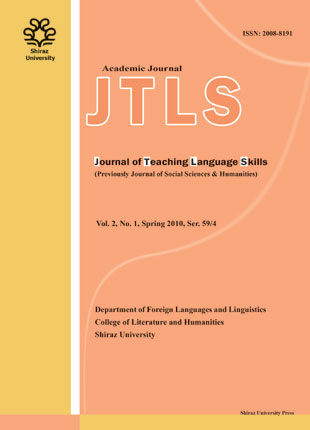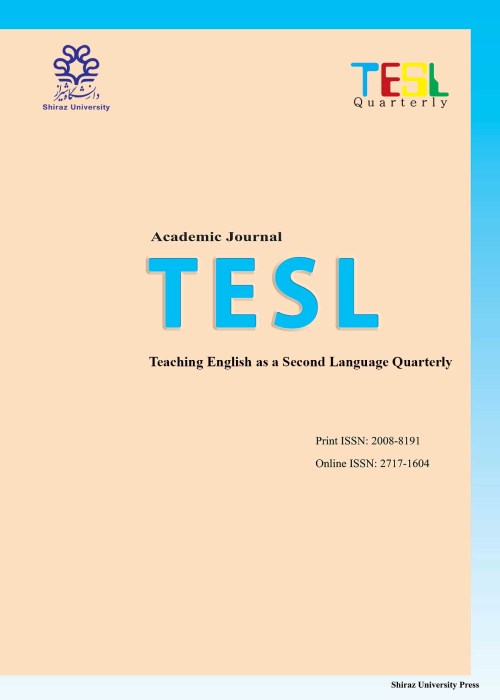فهرست مطالب

Teaching English as a Second Language Quarterly
Volume:2 Issue: 1, Spring 2010
- 184 صفحه،
- تاریخ انتشار: 1389/07/01
- تعداد عناوین: 8
-
-
Pages 1-25Language users benefit from special phonetic tools in order to communicate linguistic information as well as different emotional aspects and paralinguistic information through daily conversation. Having functions in conveying semantic information to listeners, prosodic features form the essential part of linguistic behavour, manipulating them potentially can play an important role in transmitting paralinguistic information.The importance of such a manipulation is so great that the utterance can convey completely opposite meanings. This paper aims at studying how prosodic and intonational patterns are organized in Persian in order to regulate the non-linguistic information in speech and what relations can be statistically found between different emotions such as agreement, surprise and objection and acoustic features of “bæle” in deferent contexts. Statistical results show that duration is the most effective acoustic correlate followed by pitch and intensity respectively to carry paralinguistic information.
-
Pages 27-43The transformation of industrial city into modern city entailed the change in the dominant nature of the city from the site of production to that of consumption. In the postmodern city, the trend accelerated, or better to say, heightened into "mass consumption". Consumption is no longer considered a routine and banal activity. It is rather a consciously and unconsciously affected affair that is engaged in continuous dialogue with the most vital issues of contemporary urban life such as identity, aspirations, class status and culture. This is the context into which Salinger's The Catcher in the Rye was born and thrived; therefore, it should be conceived in the same context.
-
Pages 45-66The main purpose of this study was to examine the citation patterns of discussion sections employed by local and international article writers in ESP and EGP subdisciplines of applied linguistics. Eighty article discussion sections were selected from well-established local and international journals in the field of applied linguistics, and they were sorted according to Thompson and Tribble’s (2001) framework. The results revealed that local ESP and EGP writers tended to apply the integral citations to a far greater extent than the non-integral. On the other hand, international writers used citation to a significantly higher degree than local writers; ESP writers preferred the integral over the non-integral form. In contrast, international writers in EGP articles took more advantage from non-integral types, among which they selected source more than other types. In terms of integral types, verb controlling received the highest frequency. The potential diversities existing in the discussion sections written by local and international writers suggest that international writers seem to focus more on functional than formal criteria and use a wider range of citation types, giving more credit to the works of others. These differences appeared to be related to citation patterns and discoursal conventions across subdisciplines.
-
Pages 67-89This study takes a critical discourse analysis approach to investigate the linguistic representation of male and female social actors and construction of gender identities in the Interchange Third Edition. The analytical models used are van Leeuwen's (1996) framework and Halliday's transitivity model (Halliday & Matthiessen, 2004). The findings of this study indicated a differential representation of social actors in that females were portrayed as more prominent, successful, active, independent, expressive and assertive in comparison with males. Generally, it seems that attempts have been made to bring women from margin to the foreground. Moreover, females are associated with high status activities. This challenges traditional values that exclude and demean the value of women in society implying that women are as crucial as men to the community's function.
-
Pages 91-115This study examined the effect of the ZPD-based discourse scaffolding on EFL learner's co-construction of L2 metadiscourse performing collaborative writing tasks and explored the discourse scaffolding dynamics. The participants were 160 EFL students that were assigned to four different treatment conditions: (i) formal teaching, (ii) input enhancement, (iii) non-ZPD interaction, and (iv) ZPD-based L2 discourse scaffolding. The ZPD learners were required to audio-record their task-focused social interactions and also write four weekly compositions and one delayed essay. The results showed a substantial effect for the ZPD-based L2 discourse scaffolding on the ZPD participant's use of English metadiscourse. Further, the microgenetic analysis of the social interactions revealed that the ZPD groups employed manifold scaffolding dynamics at various ZPD levels to expedite task performance and their peer's use of L2 metadiscourse. The asymmetrical discourse construction grew mutual with the less capable peers offering increasingly more self-initiated repairing moves within their activated ZPD. Also, the student's essays were rated as more reader-friendly over time. Finally, the implications for L2 research and pedagogy are discussed.
-
Pages 117-143Locus of control is said to affect learner's academic achievement. This effect has scarcely been examined within general English context. This study is concerned with examining the differences in General English (GE) course achievement among university students of humanities, sciences, and engineering. It also explores the effect of locus of control (LOC) in GE course achievement among these three groups of university students. The results of the study indicate that: 1. There is a significantly positive relationship between the university student's LOC and their GE achievement course, 2. There are significant differences in GE course achievement among the three groups of students, and 3. There are significant differences in LOC among the three groups of university students. The results of the participant's interviews were also in agreement with those of the questionnaires. The findings of this study postulate that encouraging students to seek ways to improve their self-efficacy can be really helpful for them to achieve higher scores in GE course.
-
Pages 145-163This study builds on Laufer and Hulstijn’s (2001) motivational-cognitive construct of task-induced involvement in learning vocabulary and addresses itself to its strong claim that the depth of processing is the overriding factor in learning words. The paper first re-examines the effect of processing load and then of task type on the initial learning and retention of words. To do so, 60 EFL learners from two branches of an English institute were selected. The participants were then randomly assigned to three groups: The first group completed an input-oriented task with an involvement index of three; the second group also completed the same type of task but with an involvement index of two, and the third group completed an output-oriented task with the same involvement load as that of the first group. The comparison of the performance of the groups in the immediate and delayed posttests reveals that contrary to the prediction of the involvement load hypothesis, Task 2 with an involvement index of two was superior to Task 1, which had a higher index. Besides, the participants who had completed the output oriented task (Task 3) outperformed those that did the input-oriented task (Task 1), despite their index equivalency. The study suggests that the operationalization of the levels of processing, especially evaluation, needs reconsideration.
-
Pages 165-183This study reports an experiment conducted to investigate the effectiveness of implementing MI-inspired instruction in an EFL context. To this end, a group of ten intermediate female students took part in a quasi-experimental study. At the beginning of the experiment, Multiple Intelligences Survey (Armstrong, 1993) was administered to determine the participants’ MI profiles. The participants were pre-tested using Oxford Placement Test (OPT) (Allen, 2004) to determine their level of proficiency. During the control phase, the participants received so-called ‘MI-poor’ instruction which mostly focused on verbal-linguistic type of intelligence among others. During the experimental phase, based on the initial MI survey and students’ exit slips, a variety of activities were implemented to invoke various types of intelligence. At the end of both control and experimental phases, OPT along with Headway Stop & Check tests were administered. OPT was administered to determine the participants’ general progress and Stop & Check tests were given to trace any possible specific progresses. The findings of the study revealed a significant performance on Stop & Check tests which was indicative of the at least partial effectiveness of implementing MI-inspired instruction.


